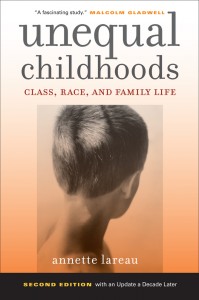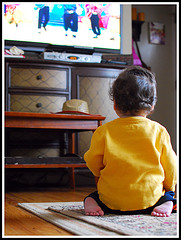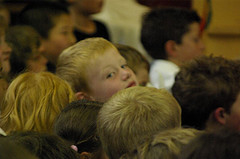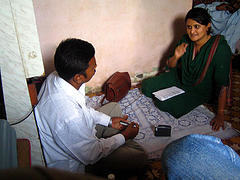Ten years after the ethnographic work Annette Lareau undertook for her best-selling text Unequal Childhoods, she’s retraced her steps, adding 100 pages to the second edition, out now from the University of California Press. In this excerpt from her Office Hours interview, Lareau talks to Kia Heise and Jack Lam about the results of concerted cultivation, as well as the methods behind her concerted ethnographic research.
Kia Heise: Lots of classrooms use Unequal Childhoods, it’s a best-selling sociology book, and the University of California Press has just come out with a second edition. Has the success of this book surprised you?
Annette Lareau: It surprised me a lot! Unequal Childhoods is actually one of the press’s Top 10 paperback best-sellers, but I wrote it because I wanted to write a book that was similar to the books I liked to read when I was in college. Tally’s Corner, I think, is a really good, classic work that not that many people read, or All Our Kin by Carol Stack. I wanted to write a book where the people, the characters, were interesting and you felt like you knew the people after reading the book.
Now, for the second edition, I did a follow-up study 10 years later. I was able to track down all 12 young people, which was actually quite a feat! I interviewed them, then did separate interviews with most of their mothers and most of their fathers and usually one sibling (if there was a sibling) to find out how their lives had unfolded in the decade after the original study.

Jack Lam: How has this book been received by the media and the broader public?
AL: Well, it is true that David Brooks wrote a New York Times column about it and describes it in his recent book The Social Animal, and Malcolm Gladwell describes it in his book Outliers. It’s a great honor to have people read it.
Some even read it in reading groups—novel-reading groups—because it’s about parenting and social class differences, and the argument is that middle-class parents see their children to be a project, trying to develop their talents and skills through reading use, through language use and time use, organized activities, and also interventions in institutions such as doctor visits or schools. Working-class or poor parents, who love their kids just as much, use scarce resources to take care of them, but then they presume that they will spontaneously grow and thrive. So, rather than answering questions with questions, they give directives, rather than organize, putting them in organized activities, they watch TV, they hang out, they get together with their cousins, and when it comes to schools, the parents turn over responsibility to the institutions and they depend on the institutions. So, I use a gardening analogy, calling the middle-class children the product of “concerted cultivation” and the working-class children and poor children the “accomplishment of natural growth.” Because it’s a lot of work—the parents are accomplishing something important—but then they’ll presume that they’ll spontaneously grow and thrive. And the middle-class children get a benefit, not because of the intrinsic value of the activity, but because they’re complying with the standards of dominant institutions, which are changing all the time—the standards are changing all the time.
Still, David Brooks wrote a beautiful summary of this research in 600 words, but at the end he concluded that the middle-class kids out-competed the working-class and poor kids, which was really not the thesis of the book. So, I think that, as in lots of things in life, people read it and they can come away with different interpretations.
And so I think one of the important things in doing public sociology is to try to really get your work out there. I believe in sociology. I believe that sociologists have a lot of really important social insights, and it’s important to share them. And reporters are so busy that the reporters from the New York Times will actually tell you, they’ll say, “It’s really helpful when an author calls us up and says, ‘You know, I see you’ve been writing about these articles and this topic, this is what I’ve done research on.’” And I’m like, “You’re kidding!” This seems like such chutzpah here! But they say it’s very helpful. So I think you have to do your best to share the results, but then I think you also have to let go of expectations that you can control how it’s used in the press.
KH: In updating Unequal Childhoods, were there any surprises?
AL: Well, one of the surprises of Unequal Childhoods in the first place was that, even though the families were very different, they were often only 30 minutes away from one another by car. But in each setting, they all felt like home, they all felt comfy, and after you got there, it felt comfortable to be there. Some of them had wood paneling and others lived in low-income housing with roaches falling out of the wall—I mean, they were all very different in terms of their facilities, in terms of how they raised their kids, but they were all home, they were all family. And I think it’s common for kids growing up to think that their family is “normal,” then they grow up and they see a variety in families. But it was hard to do the study because, if you saw two families in one day, it, I always felt like I got a headache. The inequality, the gaps in people’s lives were so profound, and then you’d be writing field notes for five or ten more hours.
Anyhow, ten years later, the gaps had really widened. For instance, what was on the line for middle-class kids ten years prior was

how kids spent their time, whether or not they watched TV or not. So, Alexander Williams, a black middle-class kid, had a piano lesson at 8:15 on a Saturday morning because his mother really didn’t want him watching TV and didn’t want to have a fight about it every Saturday morning either! Well, working-class and poor families, I learned so much about TV, TV was on all the time, they didn’t have the same hostility to TV that middle-class parents did. But ten years later, it wasn’t about TV, it was about college.
It was about, “Did you fulfill the classes you needed to fill to apply to college? Did you know how to apply to college?” There was a lot of informal information about college that one group had and the other didn’t. So there was one girl who didn’t appear in the book who graduated from city high schools and had test scores that were the day’s equivalent of about 1000 out of 2400 in today’s SAT system (which is a typical score in a large, urban district). So she applied to a lot of colleges, and her mother said the process was between her and her school counselor. The girl, she applied to colleges where the SAT range was more like 1500-1800. If she was my daughter, probably I could have gotten her into a college, I could have found a college with a program for kids who have learning disabilities and gotten her a place. But I would have had to have a lot of informal knowledge about what kind of college to apply to, how to go about it, how to take her skills and package them, maybe do an extra year or something. And so, it’s just so clear that it’s not just about wanting to succeed and trying to succeed—she applied to 7 colleges! She got rejected from all of them. And she went to community college and then it was a lot faster for her and she wanted to be a nurse and she didn’t, the textbook was $115 and she didn’t have the money but she bought it, and she stopped going but she didn’t withdraw from the class, so she failed the class and got the bill, you know? So, little things become big things in the transition to adulthood.
Middle-class kids, I think, have cumulative advantages. There are little things that their parents intervene with, which end up then becoming big things because they avoid problems or if there are problems, they repair the problems. And so middle-class children benefit in countless ways from their parents’ intervention, but those are very hard to capture on a survey, because a survey, by definition, has to have standard answers and standard questions, and so, how do you know that, you know, finding the money to buy an anatomy textbook or telling your kid to go to see an advisor to drop a course, that those are the things which really make a difference in preventing problems? Those are hard to capture in a survey.
JL: That’s true. Talking now really reminds me of the 7-Up project. Are you thinking of following these kids more over time?
AL: I don’t know the answer to that entirely. Some of the families were fine with the follow-up and with the original book. But I gave them each a copy of the book, and in some cases the book really hurt their feelings. Because of that, I’m no longer in contact with all of the families. So, like Alexander Williams’ family, the black middle-class boy, Wendy Driver, the white working-class girl—it didn’t seem to have a pattern by class or by race, it was, some of the families were fine and some weren’t. So, in the 7-Up movies, he’s now at 49-Up or whatever, and has lost a lot of people. Now the kids I studied are like 25 or 26, and, in my afterward, I show where they are now. More or less, their lives are set. The middle-class kids are mostly in professional jobs and the working-class, none of the really working-class or poor kids made it into the professional arena. They’re working, but as waiters or house painters. Wendy Driver’s married to a guy who’s in the military. Their life chances are just really very different now at this point, and I don’t really think that is going to change. The working-class and poor kids might end up with more health problems earlier if you followed them over time, but I think it’s likely that the die is cast at this point.

KH: You’ve said that the middle-class kids once seemed “older” than the working-class and poor kids. How so?
AL: When they were little. When they were 10 years old, the middle-class kids were kind of blasé, they were bored. Even though they had a lot of organized activities, they would say, “Mom! I’m bored!” Like it was mom’s problem to fix this, you know? And working-class and poor kids had very few organized activities (if any), and they had time to fill, but they almost never complained about being bored. And in organized activities, which were very rare in the working-class and poor kids’ lives, for example, if there was a concert at the school, a spring concert, the middle-class kids looked kind of bored on stage, and they looked older! The working-class and poor kids looked very excited over the spring concert, and they’d be bouncing up and down on stage, so they looked younger. And, we had a pizza party at the end of each of our visits as an exit party with a cake, a bakery cake. For the middle-class kids, it wasn’t that special for them, because they had pizza all the time. But the working-class kids were very excited about it.
Ten years later, it was different because the working-class kids often had, had been working sometimes since they were 14 (like Harold McAllister, a black, poor kid), or they had car payments, they were working, or they were unemployed. Some had kids of their own, so they seemed kind of older and worn. They were still hopeful, but they were older. And the middle-class kids were in college and hoping to travel, and they seemed younger. It was like the pattern had been reversed.
JL: I know you’re in the process of writing a book on qualitative research. Can you tell us a little bit about that?
AL: I am writing a book on ethnography that I’m excited about. It’s a practical guide to ethnography, and so the idea is that when you do ethnographic research—which I think is very valuable, participant observation is extremely valuable—I think you need first to dream. Even if your project seems really hard, like following around a professional sports team, I wouldn’t give it up. Like, when I was doing Unequal Childhoods, people told me it couldn’t be done. They said, flat out, no one will ever agree. And so I was worried about it, and I tried to do it. The project is very ambitious, it’s not a role model for graduate students—I think a graduate student project should be much smaller, maybe nine months of participant observation and maybe 15-20 interviews—so Unequal Childhoods was sort of crazy how ambitious it was. So I would recommend a more manageable project than that!

But I also think there are practical guidelines ethnographers need, like what to wear, what food to bring (like I bring pies because I like desserts to interviews, but anything would work, you know, you’re just trying to warm up the interaction). Ethnographers need to know when do the details matter and when do they not matter. So I think the practical guide to ethnography I’m writing is about how to do ethnography and also what to worry about and what to let go. There’s something chaotic about ethnography for everybody! There’s a lot of uncertainty, you don’t really quite know what you’re doing, and you’re often very confused, , but I think it’s also important to try to figure out who you are, what you’re doing in the field, why you’re there, and what you’re aiming for. It may not go that way exactly, but it gives you a sense of what you’d like this study to be one day if all goes well.
In my first book, Home Advantage, I have a long confessional appendix, and I felt there were some good ethnographic guides (William F. Whyte has a very good one in Streetcorner Society that’s used in many courses), but I felt that some books have kind of a smug tone. They say, “Well, I went in, I built rapport, and I wrote my book.” I mean, they act like everything went smoothly! And the reality is, there are always bumps, there are always problems, and I thought that sometimes people weren’t giving enough of a realistic picture of how difficult and challenging ethnography can be. And so, I’d like to put in my two cents on the topic!

Comments 2
chris uggen — March 5, 2012
Nice interview! I'm looking forward to the new practical guide to ethnography -- and already thinking about how I might bring pie to a prison interview...
Jurassic World and Education | sergioplazathethird — June 17, 2015
[…] teachers and administration I worked with, but also other AmeriCorps Members and at times, myself. Directives are more common for children from poor or working-class families than it is for those fro… Students being seen as numbers rather than people is an issue I struggled with throughout the year. […]